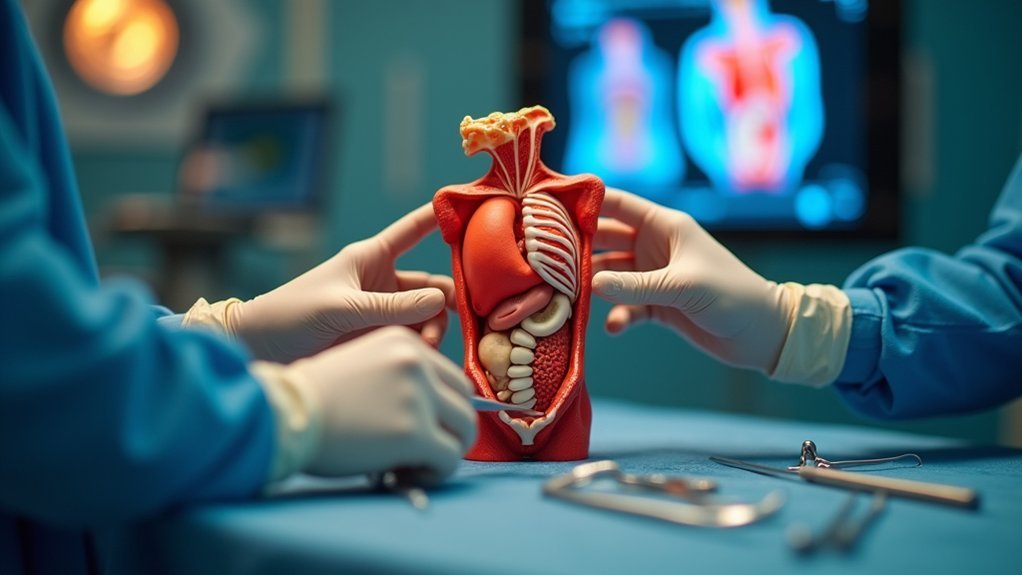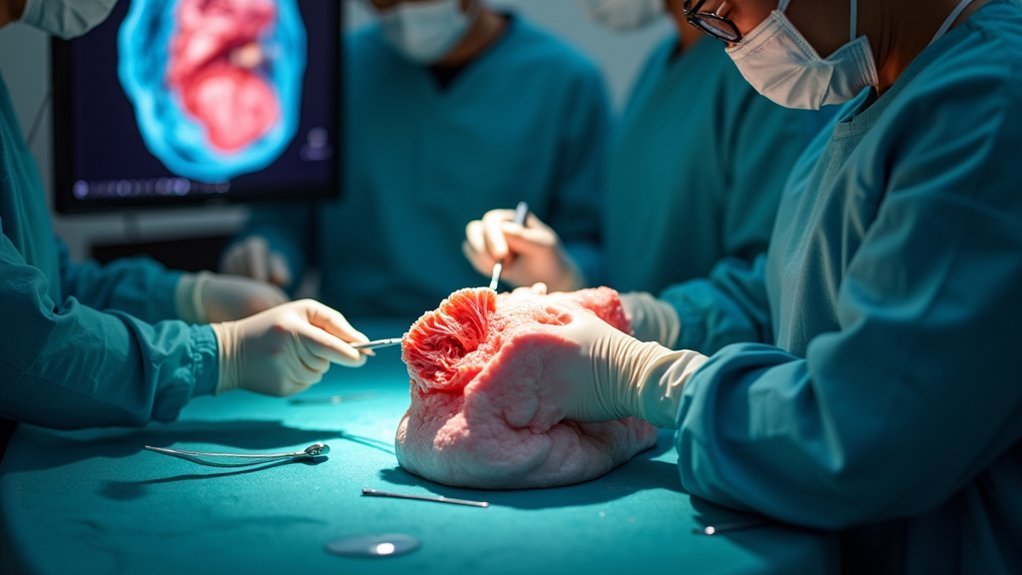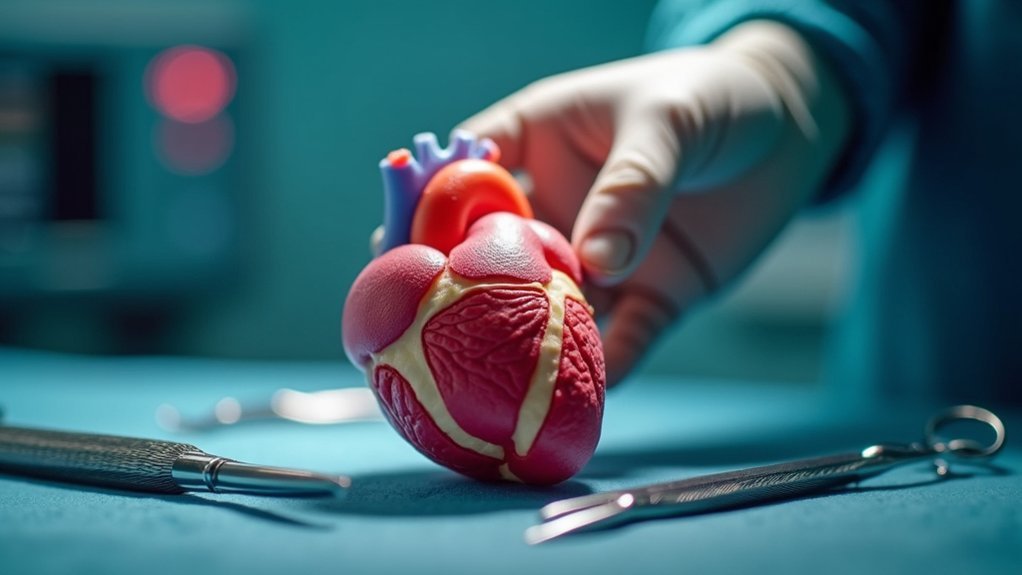You’ll dramatically improve surgical outcomes by using 3D printed models that provide tangible, patient-specific anatomy replicas for pre-operative planning. These models help you reduce operating time by an average of 59 minutes per procedure while enabling modifications to surgical plans in nearly 50% of cases, preventing potential complications. You’ll also cut costs considerably, with savings ranging from $1,534 to $4,720 per surgery, while enhancing patient communication and surgical team education for extensive benefits that extend far beyond the operating room.
Enhanced Surgical Planning and Precision

When you’re preparing for complex surgery, 3D printed models revolutionize how you visualize and understand patient-specific anatomy. These models enhance your surgical planning by providing tangible, three-dimensional representations that surpass traditional imaging techniques.
You’ll gain unprecedented surgical precision as you interact with exact replicas of your patient’s anatomy before entering the operating room.
The benefits extend beyond visualization. You’ll reduce operating time by an average of 59 minutes per procedure, creating substantial cost savings.
Nearly half of surgical cases using 3D-printed models lead to modified surgical plans, helping you avoid postoperative complications. During surgery, real-time interaction with these models supports better decision-making, ultimately delivering improved surgical outcomes and enhanced patient safety through more informed surgical approaches.
Reduced Operating Room Time and Costs
Beyond improving surgical outcomes, 3D printed models deliver substantial financial benefits by dramatically cutting operating room time and associated costs.
You’ll save an average of 59 minutes per surgical procedure, translating to cost savings between $1,534 and $4,720 per surgery.
When you establish in-house production, patient-specific 3D models become ready within 6 to 10 hours, markedly reducing pre-operative planning time compared to external services.
You’ll achieve improved surgical efficiency, with 78% of surgeons reporting enhanced performance when utilizing these models.
The financial viability becomes clear when you consider the $150,000 annual operating cost reaches break-even in just 32 cases.
Improved Patient Safety and Outcomes

While financial benefits alone justify implementing 3D printed models, the most compelling advantage lies in their profound impact on patient safety and surgical outcomes.
When you utilize patient-specific 3D printed models for surgical planning, you’re dramatically reducing risks during procedures. Nearly half of surgical cases result in modified surgical plans based on insights from these models, directly preventing postoperative complications that could jeopardize patient wellbeing.
The tactile feedback these models provide transforms your training experience, allowing realistic practice that traditional methods can’t match.
You’ll develop superior suturing techniques and enhanced procedural skills. This improved surgical efficiency translates to better-prepared surgeons entering operating rooms.
Ultimately, 3D printed models create a thorough safety framework that enhances patient safety while delivering consistently superior surgical outcomes for every patient you treat.
Advanced Medical Education and Training
You’ll find that 3D printed surgical models revolutionize medical education by offering realistic simulation training that closely mimics actual tissue properties and surgical scenarios.
When you train medical students with these advanced models, they’ll achieve markedly better performance outcomes, scoring higher on exams while completing tasks faster than peers using traditional methods.
You’re also making a cost-effective educational investment that increases student engagement and interest in surgical specialties without requiring expensive cadaveric materials or clinical time.
Realistic Surgical Simulation Training
As medical education evolves toward more sophisticated training methods, 3D-printed models have revolutionized surgical simulation by delivering realistic tactile feedback that closely mimics actual human tissues.
You’ll find that medical students and residents gain superior skill acquisition when training with these models compared to traditional pads. Studies demonstrate that you’ll achieve considerably higher performance scores while reducing training time through enhanced learning efficiency.
When you incorporate 3D-printed models into pre-surgical planning, you’re joining the 94% of surgeons who recognize their educational value.
These realistic simulations offer you a sustainable alternative to cadaver-based training, allowing multiple reuse cycles while minimizing waste. You’ll experience improved surgical training outcomes through hands-on practice that prepares you for actual procedures with greater confidence and precision.
Enhanced Student Performance Outcomes
When medical institutions implement 3D-printed models in their surgical training programs, student performance outcomes improve remarkably across multiple measurable metrics.
You’ll see medical students achieve notably higher scores on performance exams when they’ve trained with 3D models rather than traditional suture pads—scoring 31.6 versus 28.3 points respectively. Your students will also complete surgical tasks faster, averaging 26.7 minutes compared to 35.2 minutes for conventional training methods.
The realistic feedback from 3D models enhances engagement and creates more effective interactive training experiences.
You’ll notice increased student interest in surgery, with perceived training importance rising from 8.1 to 8.9 points post-training. This thorough approach addresses gaps that repetitive traditional methods can’t fill.
Cost-Effective Educational Investment
The economic advantages of 3D-printed surgical models make them an exceptionally smart investment for medical education programs.
You’ll find that 3D models deliver exceptional value through their reusability, lasting 8–15 cycles while reducing material waste considerably. This cost-effective approach eliminates expensive cadaver procurement and maintenance costs that traditional training methods require.
Your medical students will achieve superior performance scores—averaging 3.3 points higher than those using conventional training pads.
The enhanced tactile feedback these models provide accelerates learning, reducing surgical training time by an average of 8.5 minutes per session. This efficiency translates to lower operational costs and faster skill development.
You’re investing in technology that builds proficiency while maximizing your educational budget’s impact through sustainable, repeatable training solutions.
Better Patient Communication and Understanding
Ninety-two percent of surgeons confirm that 3D printed models offer a more thorough view of patient anatomy than traditional imaging, revolutionizing how medical teams communicate complex surgical procedures.
These patient-specific models transform abstract concepts into tangible demonstrations, greatly improving patient comprehension of their conditions and upcoming operations.
You’ll find that 3D printed models appreciably reduce patient anxiety through interactive discussions that allow visualization of exact surgical areas.
This hands-on approach facilitates better informed consent, as patients can physically examine the regions requiring treatment.
The enhanced understanding creates stronger trust between you and your healthcare providers, directly contributing to improved patient satisfaction and treatment outcomes.
When patients truly grasp their surgical procedures, they become more confident partners in their healthcare journey.
Real-Time Surgical Guidance and Reference

When you’re performing surgery, 3D printed models serve as tangible references that you can physically handle and examine throughout the procedure.
You’ll find these models enhance your surgical precision by providing real-time guidance that helps you navigate complex anatomical structures with greater confidence.
This intraoperative interaction allows you to make more informed decisions and adapt your techniques based on the specific challenges your patient’s unique anatomy presents.
Intraoperative Model Interaction
While preoperative planning establishes the surgical roadmap, intraoperative interaction with 3D printed models transforms how surgeons navigate complex procedures in real-time.
Patient-specific 3D-printed models provide immediate tactile feedback that enhances your spatial understanding during the most critical moments of surgery.
The benefits of this printing technology include:
- Enhanced surgical efficiency – 78% of surgeons report improved performance with 59 minutes average reduction in operating room time
- Improved real-time decisions – Tactile feedback from models helps you make better choices, reducing complication risks
- Modified surgical planning – Nearly 48% of cases see plan changes after referencing anatomical structures during operations
You’ll find these models streamline communication with your surgical team, allowing prompt strategy adjustments while clarifying complex anatomy throughout the procedure.
Enhanced Surgical Precision
As surgical complexity increases, 3D printed models serve as your precision compass, offering tangible reference points that transform abstract medical imaging into concrete spatial understanding.
When you hold patient anatomy in your hands, you’re not just viewing—you’re experiencing the surgical landscape before making your first incision.
These models revolutionize surgical precision by providing real-time guidance throughout procedures.
You’ll find that tactile feedback enhances your familiarity with unique anatomical variations, enabling informed decision-making when critical moments arise.
Studies demonstrate that 78% of surgeons experience improved surgical efficiency, reducing operating room time by an average of 59 minutes.
Frequently Asked Questions
What Are the Benefits of 3D Printing in Surgery?
You’ll enhance pre-surgical planning with thorough anatomical views, reduce operating time by 59 minutes, cut costs considerably, improve surgical efficiency by 94%, and accelerate training performance while decreasing educational time requirements.
Why Is 3D Printing Used in Healthcare?
You’ll find 3D printing revolutionizes healthcare by creating patient-specific anatomical models, custom prosthetics, and surgical instruments. It improves precision, reduces costs, enhances training, and enables personalized treatments that weren’t possible before.
What Are the Benefits of Using 3D Printing in Prosthetics?
You’ll get custom-fitted prosthetics made quickly and affordably. They’re lighter, more durable, and function better than traditional options. You’ll experience improved comfort, satisfaction, and quality of life with these personalized designs.
Why 3D Printing Is Used for Custom Medical Devices?
You’ll get perfectly fitted devices since 3D printing creates custom medical implants from your specific anatomy data. You’ll experience faster recovery times, reduced surgical complications, and receive your personalized device within hours instead of weeks.





Leave a Reply